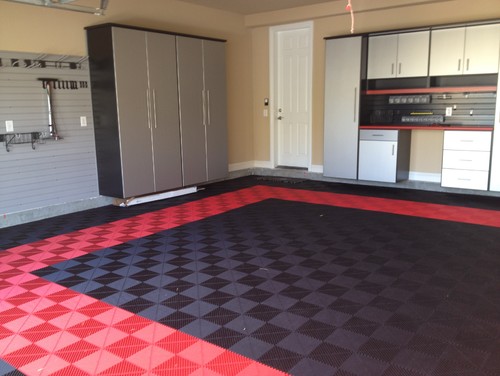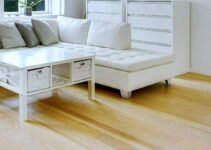The days of having a bare concrete floor in your garage are long gone, and today you have an increasing number of choices: ceramic tiles, paints, concrete densifiers (a chemical applied to a concrete surface in order to fill pores), modular tiles and of course, epoxy. Not only do they look great, they are easy to clean, come in many different colors and designs, and help protect the concrete from harmful chemicals, oil spills, salt, and stains.
What is the best garage floor covering for you?
First of all, to find the best garage flooring system for you, you need to decide what aspect of flooring is most important to you.
Let’s see the different types of garage floor coverings, the advantages and disadvantages, to help you decide which garage cover is the best fit for your needs.
Epoxy Paints
Advantages:
Epoxy paints are a popular choice because when they’re new, they provide a nice shiny finish and a seamless surface.
If you don’t mind a little hard work this is a great concrete floor covering. This option is also, somewhat durable and it is very budget friendly.
Epoxy garage coverings can be highly decorative or just plain gray. Decorative chips can be broadcast into the epoxy for a granite or terazzo look.
Good quality paints or coatings can last for years, if they are applied properly and in the correct thickness.

Photo by Concrete Xperts – Discover garage design inspiration
Disadvantages:
Epoxies are difficult to install, they require step by step instructions for mixing and painting on the surface. First of all, you must do solid prep work on the bare concrete, or the coating will not adhere properly. Proper prep and coating requires a minimum 1-week job for a long-lasting coat.
Epoxy is not really a good idea for a garage where car fluid spills and salt can be tracked into from outside during cold winters. Additionally, paints are notorious for staining and hot tire pickup, which leads to peeling and lifting of the paint from the subsurface.
If you’re in an area where condensation seeps into your floors, you’re counting weeks before your shiny new surface starts to peel and bubble. Slips are also a problem with smooth, coated surfaces.

Photo by My Favorite Design, Inc. – Search garage design ideas
Garage Floor Mats
Advantages:
Garage mats are a roll out, usually rubber or vinyl, covering for your garage floor.
These garage covers are the easiest to install easy to replace if they get damaged.
They are very durable and easy to clean. The 100% poly-vinyl ones are the highest quality.
Huge variety of colors and designs.
Disadvantages:
Garage floor mats aren’t as solid as you would want a load-bearing surface to be, and will distort at the edges over time. They will have to be replaced more often than the other options.
They are also difficult to apply if you have an oddly shaped garage, or items to go around such as cabinetry.
Garage Floor Tiles
Advantages:
Application is a little more difficult, but it will also be easier to apply tile to odd spaces.
They come in many standard and custom colors, and offer multiple designs and patterns to pick from.
These interlocking tiles are made of high quality PVC, require little if any surface preparation, and can usually be installed in one day. The best garage floor interlocking tiles like these use polypropylene copolymers and are 4 point injection-molded to provide the most material and best combination of load-bearing strength (50,000 pounds), temperature resistance (-22 to 248F), chemical and UV resistance, longevity (15-year warranty), portability, maintenance (replace individual tiles even from the center) and cost effectiveness.
You have also, a selection of vinyl tiles, or glazed ceramic tiles.
Disadvantages:
Glazed tiles pose the same disadvantages of painted surfaces.
With ceramic tiles, the underlying surface has to be perfectly smooth, or else you’ll get air pockets which will cause cracks.
Also, they can absorb moisture, and moisture can seep in between the cracks. This may lead to serious mold and mildew issues.
How to Choose the Right Garage Door Opener (howtobuildahouseblog.com)
Garage Floor Protector
Advantages:
Polyaspartic polyureas are a very fast setting, very durable, and highly decorative, type of garage floor paint.
It is as easy to apply as epoxy, but much more durable than any of the other floorings discussed. In fact, it is up to four times stronger than epoxy.
Like epoxies, they require the proper surface preparation but dry much faster. This fast drying technology allows you to drive on your floor the very next day.
Polyurea is chemical resistant, so those oil drips and salt tracks won’t be a problem. Neither the heat nor cold will affect polyurea; it is not even damaged by very hot tires.
It is also very moisture resistant, so you won’t have to worry about mold damage.
It comes in many color choices.
Unlike epoxy, which is very slippery when wet, polyurea has acrylic flakes that provide a non-slip surface.
Disadvantages:
Practically NONE.
Garage Floor Sealing
This is a very simple, clear or tinted, garage floor cover. It can be sprayed or rolled on. It’s easy to install and doesn’t require much surface preparation if you floor is in good shape. It is fairly inexpensive and dries in 24 hours.


